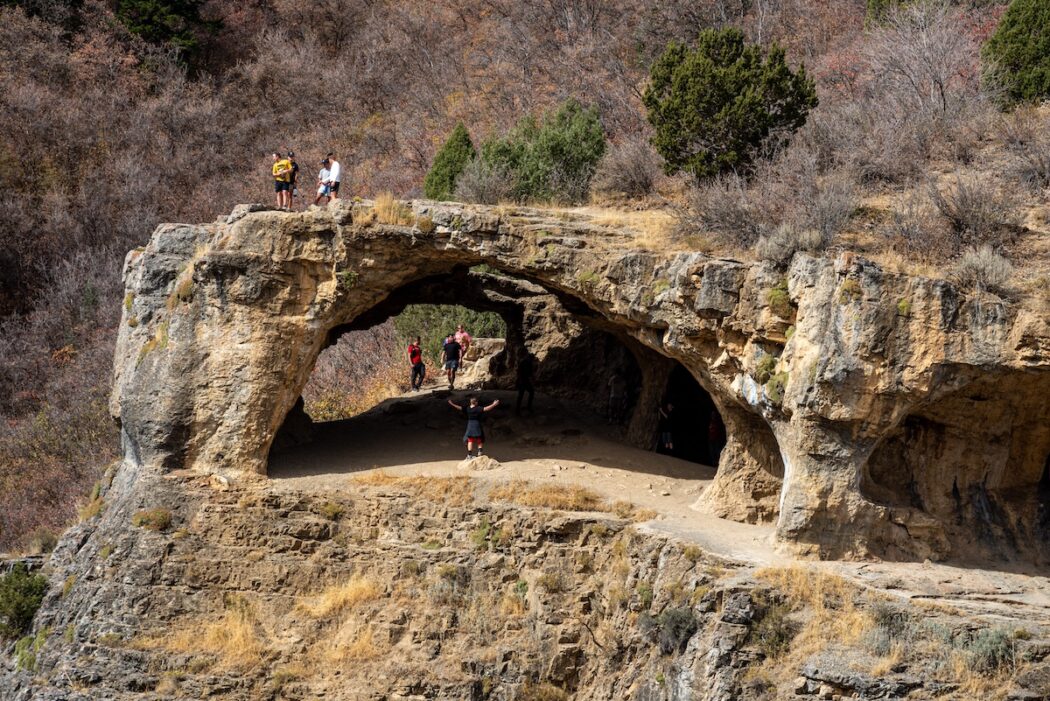Logan’s hidden landscapes: The geology of underground karst systems, caves
The caves of Logan Canyon offer visitors and locals the opportunity to explore 100 winding miles of arches, springs and towering cliffs, providing a scenic setting for outdoor recreation and adventure. But under these geological attractions lies another, harder to reach ecosystem of caves and conduits known as karst systems.
Luke Alder is a graduate student under the USU geosciences department who is researching the karst systems of the Bear River Range in Logan canyon.
“Where Logan is today, hundreds of millions of years ago it was a shallow sea,” Alder said. “Living things that were in the sea — their skeletons and shells were deposited, and they eventually turned into rock.”
These deposits are a form of carbonate rock, such as dolomite and limestone. Carbonate rock makes up the vast majority of geological features in Logan and are easily dissolved by acids.
“Rainwater is slightly acidic,” Alder said. “Water mixes with carbon dioxide in the atmosphere and carbon in the soil, and it forms a weak acid called carbonic acid.”
Over time, this weak acid erodes the sensitive carbonate rock and forms hollow caverns like the Wind Caves and the Minnetonka Cave that are visible today.
“In the Minnetonka Cave case, it has remained underground,” Alder said. “Whereas with the wind caves, that erosion is now exposed to the surface because the overlying layers have eroded away.”
This process of erosion created karst systems, an underground drainage network of caves, sinkholes and aquifers where groundwater and surface water are stored and transported throughout the canyon.
Due to the complex structures of these karsts and how deep they are below the earth’s surface, it is often difficult to track where water is flowing through the system.
“It makes it a lot more complicated to figure out where water is going to end up going, and that can complicate things a bit on the management side of things,” Alder said.
The karst systems provide Logan with a large portion of its water supply, and understanding the flow and direction of water is important when determining the amount of water resources that are available to the community.
“If we have water that moves through the system really fast, then we aren’t going to have a big backup of water supply,” Alder said. “If water moves through really slowly, then we will have some resilience to drought conditions.”
Kirsten Bahr is a physical science technician for the National Park Service and the chair of the Salt Lake Grotto club. Throughout her education, Bahr has researched caves and traversed the cold underground of Logan karst systems to study the flow of water.
“The head of the Logan River actually comes out of the karst system,” Bahr said. “There’s these little patches of karst that come out at different springs that all empty into the Logan River.”
According to Bahr, the water moves through the Logan karst systems faster than other karst systems because of its mountainous geography.
“The water is not reaching the water table until it hits the Logan River,” Bahr said. “There are some places in the Bear River range where we don’t know where the water comes out yet because it’s so complicated.”
According to an article published by American Scientist, these karst systems are living ecosystems themselves, supporting a wide variety of flora and fauna unique to the dark, cold atmosphere of the caves. The sustainability and success of the karst systems is largely dependent on the success of the living and nonliving components within them.
“It’s not really a renewable ecosystem,” Bahr said. “Once it’s damaged, it’s fairly hard to fix.”
Preservation of karst systems and the caves surrounding them is challenging when public recreation often leaves them open to damage.
“People may think the formations in caves are really cool, and they’ll break them off,” Bahr said. “That right there probably took over a thousand years to build, and it may never come back.”
Other forms of damage are more severe and can have a larger impact on the biodiversity and life within the karsts.
“You’ll get people that go in and they’ll spray paint the walls,” Bahr said. “They’re killing the microbes and the life that uses that to survive.”
According to Bahr, it’s important that visitors learn about how the health of karst systems impact the availability of a resource they use and enjoy daily.
“There’s almost a lack of teaching the importance of karst systems,” Bahr said. “I think the best way to preserve them is to educate people.”
As a cave researcher and explorer, Bahr said she values the scientific knowledge and adventure these geological formations provide and hopes to see them preserved.
“It’s those moments where you forget that the cave is a living breathing thing,” Bahr said. “It’s entirely possible to do all of those things — recreation, exploration and researching — and the caves will still be around for years and years to come.”

